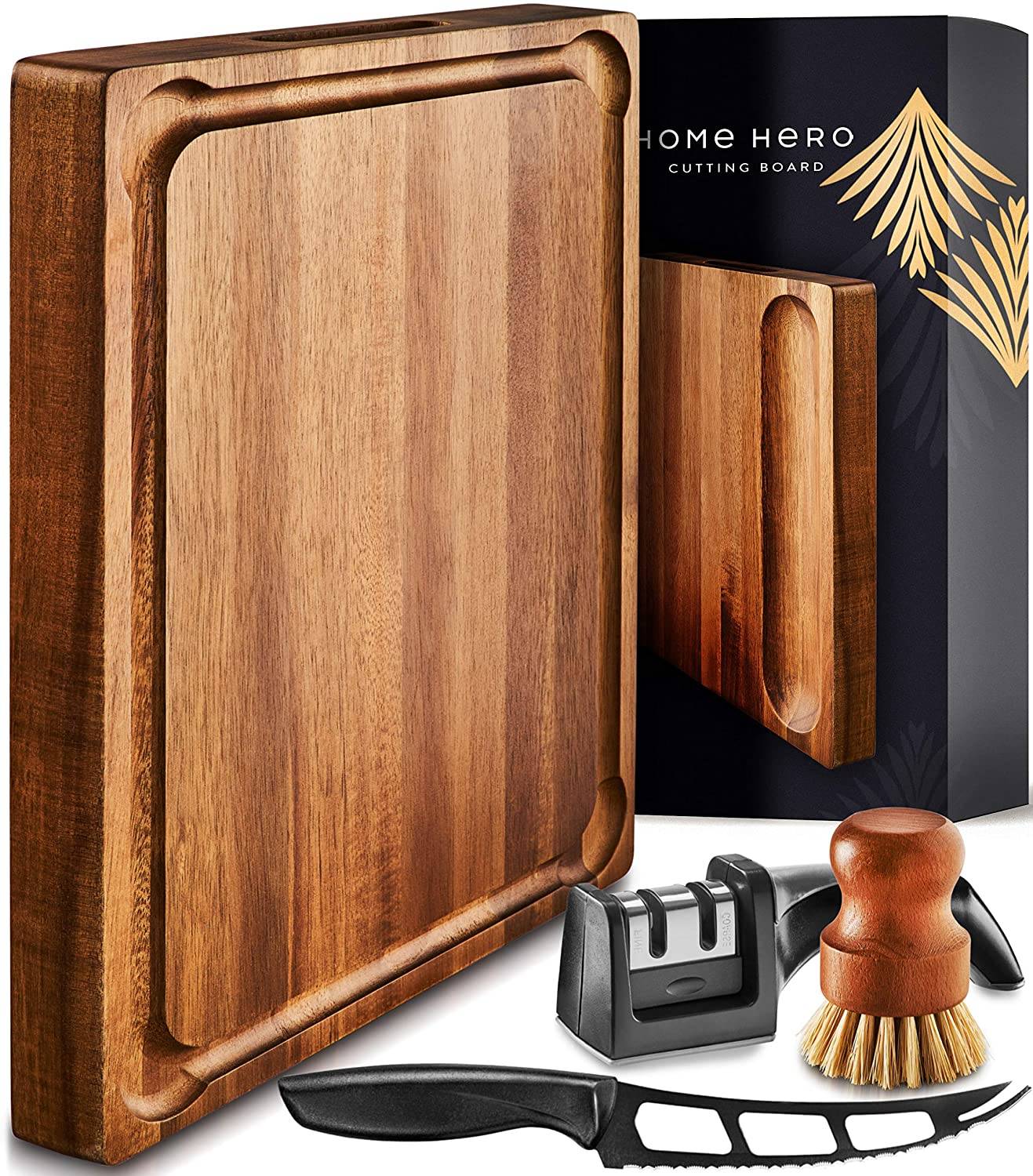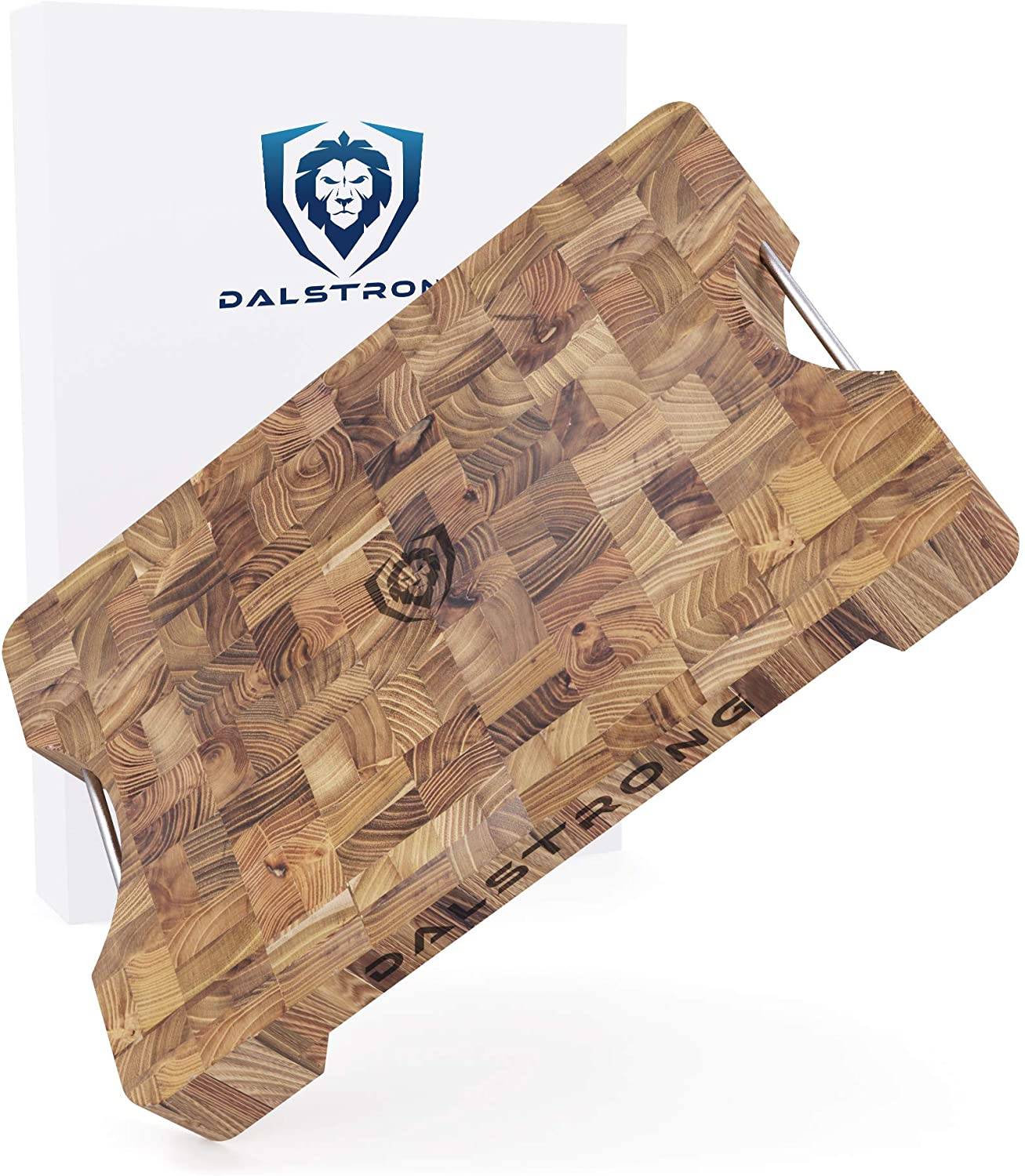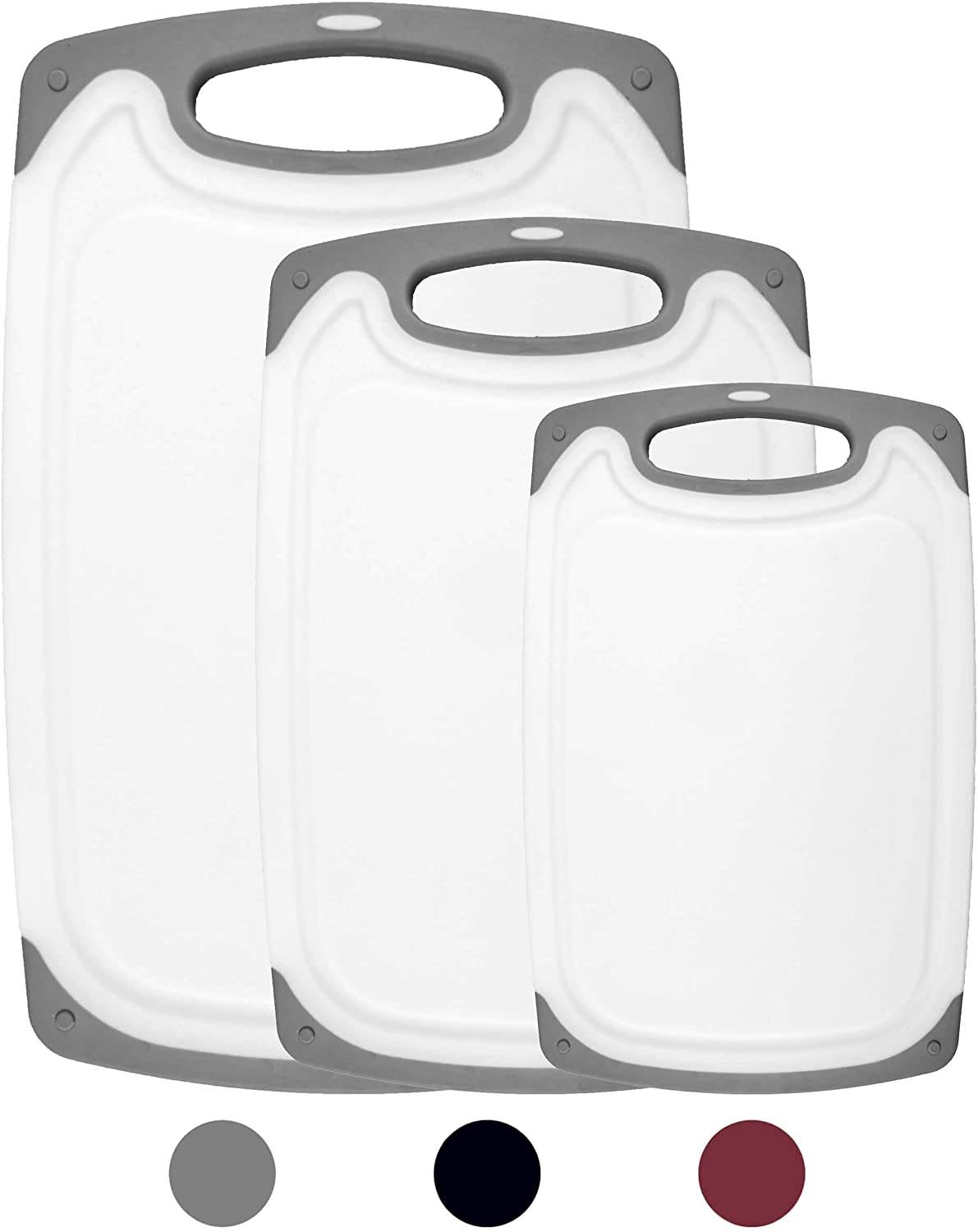Best Cutting Boards
Experienced chefs know the importance of having a good set of sharp knives to get all their cutting, chopping, slicing and dicing done quickly and efficiently. But an important factor in the food-prep game is using a good cutting board. Why? Because the right cutting surface will prevent your sharp knives from dulling while protecting your countertop from knife cuts and the liquid from messy, drippy food.
Sounds simple, right? Well, like most things, cutting boards come in a variety of shapes and sizes, and are made from either wood, plastic, rubber or bamboo. Each one has its benefits and pitfalls. Which one you choose depends upon a number of factors, including its aesthetic appeal. Generally, though, three main things should be considered: the material the board is made of, the amount of surface area and the thickness.
We narrow down the best cutting boards you can buy online. Read on to find the one that suits you best.
1) Top Pick Best Affordable Wood: Home Hero Large Wood Cutting Board
You just moved into a new home with a big, beautiful kitchen equipped with lovely countertops. As the main cook in your house, you do a lot of chopping and slicing, so you need a reliable cutting board to protect your countertops and your knives. You’d like to reduce the amount of plastic that you use, and that includes a cutting board, but that’s okay because you love wood. If you’re looking for a natural wood cutting board that also makes a great serving board, then this is the product for you.
We recommend the Home Hero Large Wood Cutting Board for all your cutting, chopping and serving needs.
This large, 1.5-inch thick, butcher block style cutting board made from Acacia wood provides stability while cutting, and the indented handles on either side provide grip for easy carrying and serving. Deep grooves around the edge capture and hold juices so they don’t end up on the counter or floor. Measuring 17.7 inches x 3.94 inches x 13.7 inches and weighing 8.73 pounds, this board is sturdy, a nice size and perfectly weighted to stay in place while you cut and chop.
Great for cutting cheese, bread, vegetables and fruit, the cutting board is reversible and designed to also function as a deluxe charcuterie board or as a wooden cheese board. Just flip it over and on the opposite side of the cutting board you’ll find a divot for holding crackers in one of it sides, ideal for dinner parties. This cutting board also comes with a cheese knife, a two-stage knife sharpener and a wooden brush to keep your wood board clear of a mess.
With the bonus knife, sharpener and brush, you could consider this cutting board as a great housewarming, birthday, anniversary or wedding gift.
Pros:
- Made from natural Acacia wood
- Sturdy, with indented handles for easy carrying
- The reverse side can be used as a serving board for cheese or charcuterie
- Makes a great gift
Pros:
- Hand wash and air-dry only
- More expensive than plastic cutting boards
Top Pick Best High-End: DALSTRONG Lionswood End-Grain Teak Cutting & Serving Board
When only the best will do – that’s your motto. You believe in spending the extra dollar to purchase something of superior quality that will last forever. That includes your cutting board. As an avid cook, you want something strong and sturdy on which to cut, chop and prepare your meals. It also has to be made from a natural product, preferably a wood suited to the rigors of a busy chef. If you’re looking for a meticulously handcrafted end-grain wood cutting board, then this is the product for you.
This superb cutting board, made from end-grain wood from sustainably sourced, tropical teak, is filled with rich moisturizing oils, making it naturally resistant to water and discoloration. An end-grain fabrication consists of fibrous wood grain in alternating directions that helps to prevent gouging in the board by allowing the wood fibers to spring back easily. The unique checkered construction of this cutting board offers a slip-resistant surface that absorbs impact, protecting your knives and helping them to stay sharper, longer.
Due to its tight wood-grain construction, this board is easy to maintain and ensures a long-lasting clean cutting surface, making it ideal in wet environments, such as a busy kitchen with lots of food prep. The thickness of the cutting board also makes it resistant to warping. Satin finish stainless steel handles give it a sleek, sophisticated look, with a practical edge for easy handling.
As well, this durable, beautiful-looking cutting board can double as a serving board, ideal for beautifully presenting your finest roasts, charcuterie, breads, cheeses and more.
Pros:
- Crafted from premium, sustainably sourced teak wood
- Naturally oily surface
- End-grain construction
- Satin-finish steel handles for ease of carrying
Cons:
- More expensive than other cutting boards
Top Pick Best Versatile Plastic Set: HOMWE Kitchen Cutting Board (3-Piece Set)
Why buy one of something when you can get a deal on more, right? Especially if it really suits your purposes, means you can be more efficient at what you are doing, and won’t break the bank. When it comes to cutting boards, sometimes one size doesn’t fit all and it pays to have different sizes to suit a variety of needs. If you’re looking for a clean food prep surface to accommodate a range of needs, then these may be the cutting boards for you.
We recommend the HOMWE Kitchen Cutting Board (3Piece Set) for all your cutting and chopping needs.
Made from a thick, heavy-duty BPA-free and latex-free plastic, these cutting boards provide a clean food prep surface for every meal. And since the pack comes with three distinct cutting board sizes – small, medium and large – it’s perfect for multi-course meals or all-day use.
Totally reversible, the cutting boards feature juice grooves to catch sticky or acidic drippings. Non-slip handles make them easy to carry and the non-porous, strong cutting surface is gentle on knives and can be put in the dishwasher for a quick and easy cleanup.
Tough enough to endure heavy chopping, slicing, dicing and sharp knives, these cutting boards won’t retain stains or odors. Specifically designed to keep your counters safe, you’ll be using these cutting boards for a long time to come. This set includes boards measuring 10 inches x 5.8 inches, 12.5 inches x 7.8 inches and 15.8 inches x 9.5 inches.
Pros:
- BPA-free
- Thicker design
- Gentle on knives and cutlery
- Dishwasher safe
Cons:
- Comes in a three-pack
Things to look out for:
Consider these things when looking for a cutting board so you will choose one that best suits your needs:
What it’s made of
Wood
Cutting boards made from wood are usually visually appealing and nice to look at, especially ones made from premium end-grain wood. End-grain cutting boards, where the wood grain is aligned so that it runs from the top of the board vertically down, toward the underside, look beautiful and also make for a softer cutting surface, helping to keep knives sharper for longer.
The surface of long-grain cutting boards, where the grain runs horizontally from one edge of the board to the other, are a bit harder, and are a little less luxurious, but are still considered to be good choice. Wooden boards can also last for years, if properly cared for.
Most wooden boards do need to be cared for. If they are exposed to too much moisture, they can warp or split along the seams. Strongly pigmented foods like beets can also easily stain them, and they can pick up lingering odors if you chop a lot of onions. Wood boards also tend to be more expensive.
Rubber
Rubber boards are comparatively inexpensive, durable, easy to clean and easy on knives. Rubber is able to simulate the same properties as wood – heavyweight and durable, yet gentle enough to retain a knife’s cutting edge. Rubber boards are also low maintenance, can hold up against most food-safe cleaning solutions, and are oftentimes dishwasher-safe. However, rubber does melt and can’t be used under a hot serving dish or as a serving platter.
Plastic
The two types of plastic most commonly used for cutting boards are high-density polyethylene (HDPE) or Polyvinyl Acetate (PVA) — with both being tough enough to cut on but still gentle enough on knives.
Plastic cutting boards are also comparatively lighter, more affordable, and available in a wide array of colors, which some cooks prefer so they can color-code their boards to prevent cross-contamination. They are also easy to sanitize, as HDPE and PVA can tolerate most food-safe cleaning solutions, long periods of soaking time, and cycles in the dishwasher.
However, plastic is not perfect. When the material is cut, it stays cut — leaving open areas where bacteria can easily enter and fester. So while plastic boards may offer an easier surface-level cleanup, they are more prone to retaining dirt, stains, and smells with every use.
Bamboo
The natural density of bamboo produces a cutting board that’s highly resistant to scarring and absorbing liquid, which means it’s less likely to harbor bacteria. Bamboo is also a renewable resource and makes a beautiful board, so you can also use it as a cheese board or appetizer tray.
Cutting board size
While there are a variety of shapes and sizes to choose from, rectangular boards tend to be the most practical, with 12 inches by 18 inches being a pretty standard size and a good choice. But cutting boards come in a variety of shapes and sizes for a reason. We all have different needs and cooking spaces, so it’s best to determine your cooking style and needs before making a decision. It’s not uncommon to have two or three cutting boards of different sizes to accommodate the specific task.
Thickness
In terms of thickness, professional grade rubber boards are thinner and lighter, typically between ½- to 1-inch thick, while a well-crafted wooden board should be anywhere from 1 ¼- to 2-inches thick.
Extra features
It’s not difficult to find a cutting board with extra features. One with rubber feet increases the stability of the cutting board and offers improved airflow, but that means you won’t be able to turn the board over and make use of both sides.
You might want to purchase a cutting board that has liquid-catching grooves, especially if you carve a lot of roasted meats or juicy vegetables like tomatoes. In some cases, for ease of portability, there are cutting boards that fold in half, which makes taking it from one location (the house) to another location (the cottage), easier. Finally, there are boards that come with added cups and trays.
Maintenance
It’s important to clean your cutting board gently with soap and hot water after every use, and if you have a wooden cutting board, thoroughly dry it with a clean dishtowel. Do not put a rubber or wooden cutting board into a dishwasher. The intense heat and caustic conditions can damage rubber boards, and will completely ruin and destroy wooden ones.
For wooden boards, it’s a good idea to coat and buff it with either food-safe mineral oil or a pre-mixed combination of oil and beeswax every two to four weeks, or more often if you want. This will help to prevent warping and splitting, and will help to protect against stains and odors.
A good idea is to store smaller wooden cutting boards vertically on their edge to help keep them dry and prevent warping and splitting. For butcher-block style boards like the larger thicker ones that you don’t move around, it’s best to not leave any standing water or food remnants on the surface.
As a general rule, the best cutting board material is one that can be easily cleaned, and doesn’t damage or dull knives.



